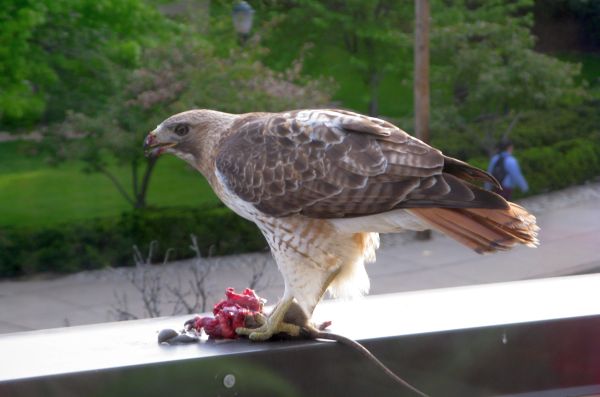
As disappointed as I am that the CMU red-tailed hawks have been raiding bird nests in Schenley Park, there’s another item on their menu that makes me happy to see them patrolling Oakland.
In early May, Lisa Zirngibl saw a red-tailed hawk eating breakfast on a ledge at Cyert Hall. (This is the female of the pair; I can tell by her pale head.)
One glance at the tail of her prey tells me this bird is performing a public service.
Can you guess what she’s eating?
I hope she catches a lot of these!
(photo by Lisa Zirngibl)
From the tail, looks like a Rattus Rattus!
she’s munching on a rat … *shudders*
Urgh, gross… What nests have they been raiding in Schenley, Kate?
I’d say the fur is to light for rattus rattus. It’s probably just a rattus norvegicus, but I don’t really know much about rats. (Dirty flea-ridden pestilences)
Looks like a BIG rat by the size of the meal…way to go!
I’ve seen them raiding robins’ nests & suspect they raided the summer tanagers’ nest. It is so heart-breaking to see the parent robins shouting/screaming and there’s nothing they can do.
I have a question. I have just heard that an energy-generating wind mill, 40ft high, will be built at Phipps Conservatory. Wind projects have been documented to slaughter thousands of birds, including peregrine falcons, eagles, red-tailed hawks, and owls. There may also be subliminal noise pollution that is physiologically quite damaging. I am very concerned about the potential toll this project may exact on our recovering raptor population and other wildlife. Why not solar?
I hadn’t heard about this but am not worried by a 40-foot tower. That’s only four stories tall — just slightly taller than Phipps. It will stand alone in a place that is not in a migration path so it won’t have many birds go anywhere near it.
Altamont Pass Wind Farm (the famous killing windmills mistake) houses nearly 5,000 small windmills in a place favored by raptors. The small towers have struts that raptors use as perches and then die as they fly off. See pictures & info here:
http://en.wikipedia.org/wiki/Altamont_Pass_Wind_Farm
There is a huge difference between a single short windmill in a city and 5,000 windmills in California’s ground squirrel & raptor habitat.
Windows, not windmills, are the big killer of birds. Many, many, many birds die by hitting windows/buildings — up to 2.7 millions birds per day in the U.S. The USSteel Building (for instance) probably kills more birds today than it did a few years ago because it now has a bright white sign (“UPMC”) on all three sides. In fog, that light attracts migrating birds who smash headfirst into the glass.
In 2008 one of Pitt’s peregrines died by smashing into a window. This is the article I wrote about windows then: http://www.birdsoutsidemywindow.org/2008/07/10/windows-kill/
Sadly, it still applies.
The reason not to go with solar is that to generate any substantial amount of power you have to take up a lot of space and invest and astronomical amount of money in your initial investment. If it were not for taxpayer dollars going to subsidies no one would even dream of using solar or wind power. Furthermore, using solar on a large scale offers uncertainty in the power grid since a few cloudy days in a row could potentially create a huge problem if solar is a significant percent of the grid. The same applies to wind, or course, since wind power requires certain wind conditions that are not always present. Last but not least, if the initial investment doesn’t bother you at a time when the government is deeply in debt at almost all levels, one must remember that fossil fuels are used to create solar panels. Because the process is so high tech, it requires a large amount of fossil fuels to create a solar panel.
In reply to this discussion from 2011: That’s the year Phipps’ solar array was installed.
Phipps solar installation is: “A 125 kW solar array and a vertical axis wind turbine generate electricity for the (Center for Sustainable Landscapes) building. Combined, they generate more electrical power than needed. The excess is used to power other parts of the Phipps campus.
You can see the array under construction at https://www.energysage.com/project/6775/going-solar-at-phipps-conservatory/.
In the photo at https://greenbuildingelements.com/2015/03/25/phipps-building-gets-sustainability-award/ you can see where the array is located at the bottom right. The little white thing sticking up near the production greenhouses is the wind turbine.
People in Pittsburgh who have installed solar panels are able to supply 100% of the power for their homes in most cases. The main problem with solar power is storage to have power when the sun is not shining. China has undertaken a huge project to develop means of storage.
Phipps can’t use solar on its roof because it’s a huge greenhouse & they are already using the sun to light the plants inside their building. Solar panels would cover the greenhouse glass & not let any light in.
Energy discussions aside, to prevent bird deaths we need to do something about glass. The National Aviary thought ahead and made sure that the glass on their new concourse is “see-able” by birds. Read about it here: http://www.aviary.org/abt/pressroom_release.php?itemid=128